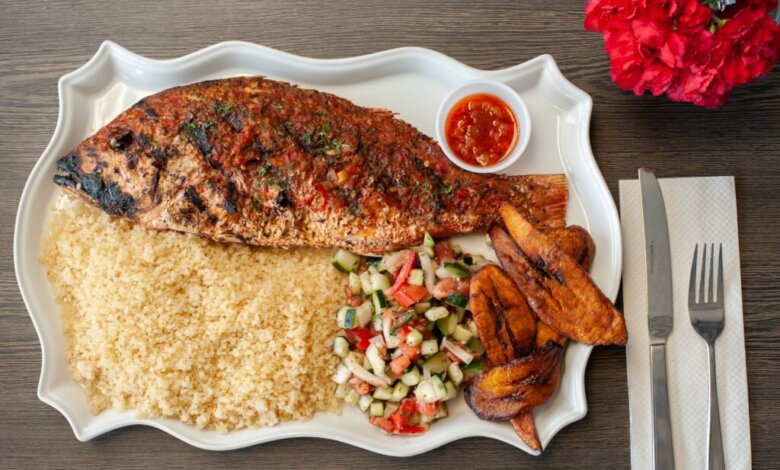Here’s why attiéké from Ivory Coast is taking over the global kitchen

Attiéké is an Ivorian national dish made from cassava, and it’s been a major part of the country’s kitchen for generations. It’s a simple food; grated, fermented, and steamed into small grains, that people in the West African country eat with fish, stew, or spicy sauces.
In December 2024, UNESCO recognized it as part of the world’s intangible cultural heritage during a meeting in Asunción, Paraguay, putting it on the map in a way it was never before. What started as a local favourite in West Africa has now spread to cities like Paris, London, and New York.
Attiéké comes from cassava, a root crop that grows well in tropical places like Ivory Coast. To make it, Ivorians peel the cassava, grate it into a pulp, let it ferment for a couple of days, press out the extra water, and then steam it into small, dry grains.
The process takes time and skill, and in Ivory Coast, it’s mostly women from southern communities, like the Ébrié, Adjoukrou, and Alladian, who handle it. These groups live around the lagoons near the coast, and they have been making attiéké for generations.
In places like Abidjan, the country’s biggest city, it’s everywhere. You can buy it from street vendors who serve it with grilled fish or chicken, or eat it at home with whatever’s in the pot.
It’s affordable, it fills you up, and it goes with almost anything, which is why it’s been a fast food to the locals for a long time. The name “attiéké” comes from the Ébrié word “adjeke,” showing how tied it is to that community’s way of life.
Taking attiéké abroad
Over the past decade, African cuisine has been getting more attention globally. People are into trying new flavours, and dishes like jollof rice from Nigeria or injera from Ethiopia have paved the way. Attiéké fits right into that trend. It’s different from anything Westerners are used to, with its slightly sour taste from fermentation and a texture that’s not quite like rice or couscous.

Food writers started mentioning it, social media posts showed it off, and it became a part of the food trend conversation. As Ivorians moved to other countries for work or better opportunities, they brought their food with them. France was one of the first places it landed, owing to the large West African population there and its historical connection from colonial days.
In Paris neighbourhoods like Château Rouge, you can find attiéké in markets, either fresh or packaged, sold next to ingredients for stews and soups. Immigrants cook it to feel at home, but soon other people started trying the delicacy too.
From there, it spread further. In the United States, cities with growing African communities, like New York, Atlanta, and Washington, D.C., saw attiéké show up in restaurants and stores. Ivorian families would make it for gatherings, and eventually, non-Ivorians got curious. Some opened small businesses to sell it, while others introduced it to friends who had never heard of Ivory Coast.
The business side
Since it’s made from cassava, it’s gluten-free, which appeals to people with dietary restrictions. The fermentation gives it a bit of a health boost with probiotics, and it’s low in fat but high in energy, making it a solid choice for anyone watching what they eat. As health food trends grew, attiéké found a niche alongside things like quinoa or chia seeds, even if it’s been around way longer.
Making attiéké isn’t quick or easy, but that hasn’t stopped it from going commercial. In Ivory Coast, women have always been the ones producing it, often in small batches for their families or to sell locally. As demand went up, some turned it into a business.

They figured out how to dry it or freeze it so it could ship overseas without going bad; cassava rots fast, so that was a big hurdle to clear. Now, it’s available in African grocery stores in Europe or the U.S., packed in bags and ready to cook.
Entrepreneurs played a big role too. In places like London or Houston, Ivorian immigrants opened eateries serving attiéké with local twists. Something like attiéké with barbecue or spicy shrimp. Bigger companies noticed the hype and started stocking it in supermarkets, putting it on shelves next to other grains with labels that play up its “authentic” roots. It’s still a niche product, but it’s growing, and the people behind it are finding ways to keep up.
More than just a food
For Ivory Coast, attiéké is a point of pride. It’s not just something to eat—it’s part of who they are. The UNESCO recognition in 2024 was a huge deal because it told the world that this dish, and the culture it represents, is worth protecting. The food is tied to the country’s history, its people, and the way they’ve made the most of what they have. As it spreads, it’s putting Ivory Coast on the map for something positive.
But there’s a flip side; some Ivorians worry that if attiéké gets too popular, it’ll lose what makes it special. Mass production could water it down, turning it into a generic product that doesn’t reflect the hands-on care it started with.
Others see it as a chance to boost the economy since more demand could mean more jobs for cassava farmers and producers back home. It’s a balancing act between growth and staying true to the roots. However, attiéké is not slowing down. Chefs in big cities are testing it out in new ways, like mixing it into salads or using it as a base for fancy dishes.
Home cooks are finding it online or in stores and swapping it into meals where they’d usually use rice or pasta. As African food keeps gaining traction, attiéké could become a regular sight in kitchens everywhere.
Oral Ofori is Founder and Publisher at www.TheAfricanDream.net, a digital storyteller and producer, and also an information and research consultant.




